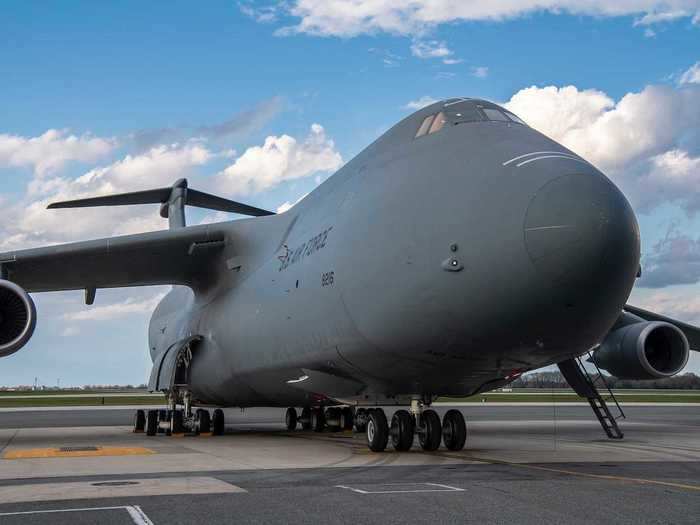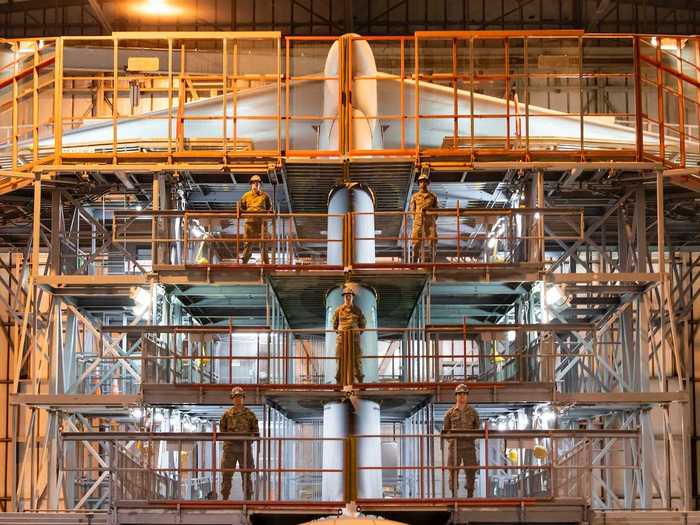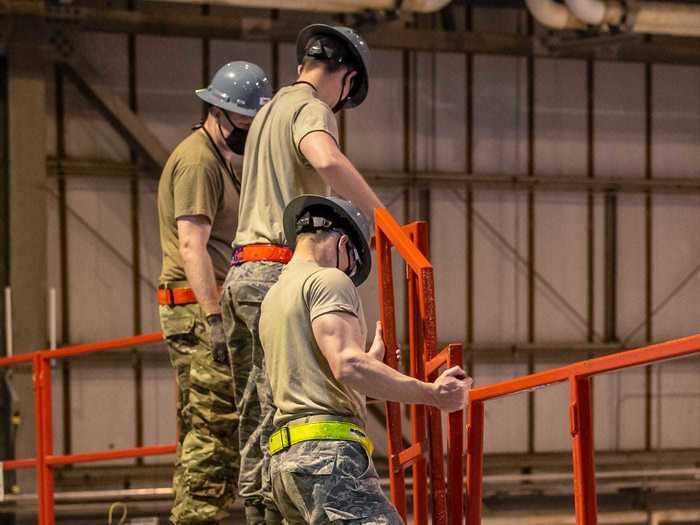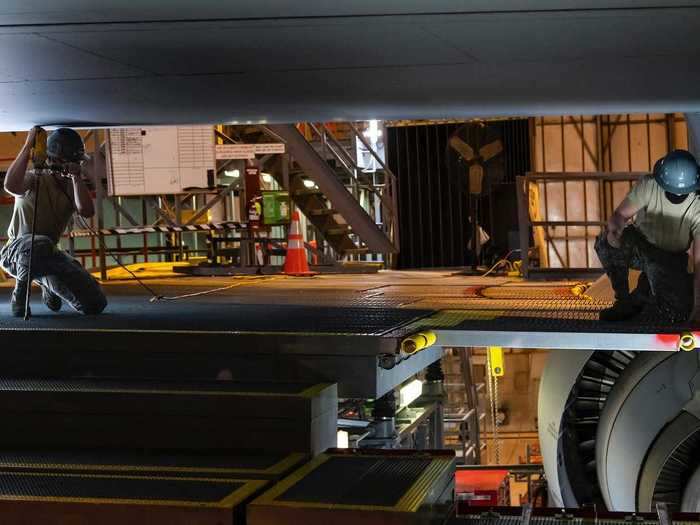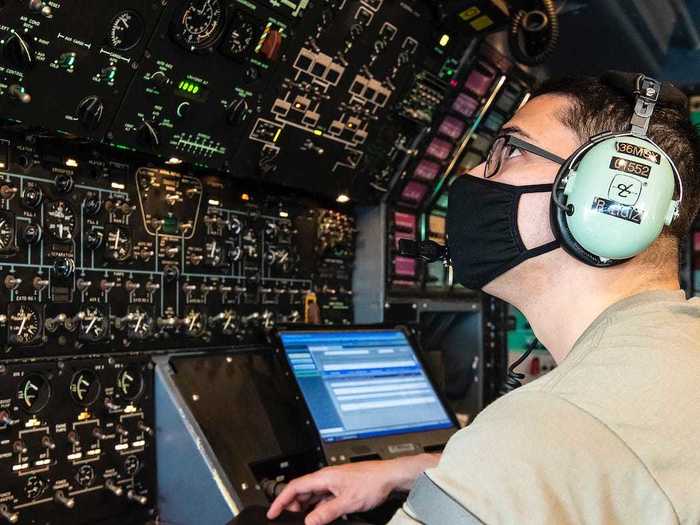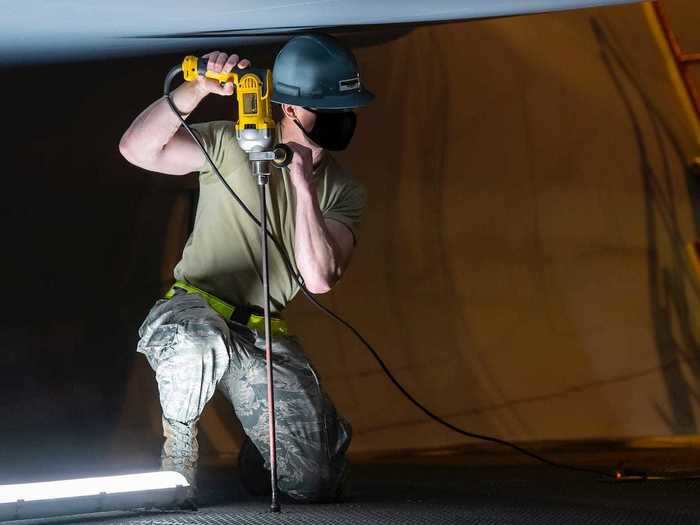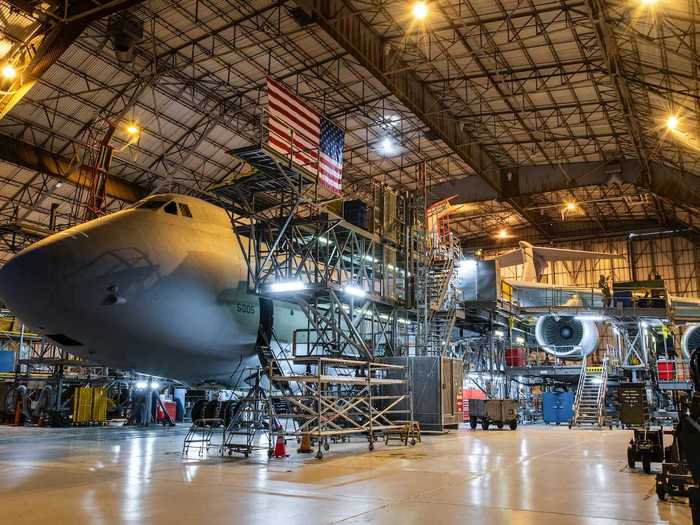A C-5C Space Cargo Modified Galaxy from Travis Air Force Base, California, on the flight line at Dover Air Force Base, Delaware, April 8, 2020.US Air Force/Senior Airman Christopher Quail
- Maintainers at Dover Air Force Base are still working to keep the Air Force's C-5s flying amid the coronavirus pandemics.
- Technicians from the 436th Maintenance Squadron are working around the clock while taking safety precautions in order to get inspections done.
- Visit Business Insider's homepage for more stories.
DOVER AIR FORCE BASE, Delaware – The 436th Maintenance Squadron technicians still keep the mission going despite COVID-19, ensuring the C-5s of the world's greatest Air Force are up and running.
The team is currently tasked with working on one major inspection on a C-5C Space Cargo Modified Galaxy that belongs to Travis Air Force Base, California, and one minor inspection on a local C-5M Super Galaxy.
"We just finished an engine run, auxiliary power unit check and pressurization run on the C-5C outside. After that was completed, we towed the aircraft into a fuel cell, so everything fuel-related can be worked on inside a special hangar that is just for fuel work," said Senior Airman Nicholas Gardiner, 436th Maintenance Squadron C-5 regional isochronal journeyman. "Right after the C-5C was towed in, we had to get ready for the tail stand of the other inspection we are working on for the Dover C-5M."
Read the original article on
Business Insider
"With the teams being small, you get really close to a lot of the guys you work with here and learn a lot from one another," said Gardiner. "We built a great team here, and all the guys I work with are amazing. I trust them with anything that they do and would fly on any of the aircraft that they work on."
A C-5C Space Cargo Modified Galaxy from Travis Air Force Base, California, is parked on the flight line at Dover AFB, Delaware, April 8, 2020.
US Air Force/Senior Airman Christopher Quail
The night shift team that usually has at least 14 members is down to seven airmen. With manning being cut in half and the team still needing to complete the mission on time, Gardiner assures everyone that it is only making them stronger.
Five 436th Maintenance Squadron aircraft maintenance personnel in the Isochronal Inspection Dock on Dover Air Force Base, Delaware, April 10, 2020.
US Air Force/Senior Airman Christopher Quail
"We have gloves that we use both for our maintenance tasks, but we are also using for the stop of spreading things," said Padoll.
436th Maintenance Squadron aircraft maintenance personnel place guardrails along the edges of the stands in the Isochronal Inspection Dock on Dover Air Force Base, Delaware, April 9, 2020.
US Air Force/Senior Airman Christopher Quail
"We also are using cleaning supplies, making sure we take care of our facility, sanitizing that while additionally sanitizing our tools once we are done using them for the night, so we don't transmit that to the next group. Additionally, we are wearing masks, because sometimes, completing the mission requires us to be close."
"One of the biggest preventative measures that we are taking is splitting our folks," said Tech. Sgt. Adam Padoll, isochronal night shift supervisor. "So right now, the team that is working this week will be off next week, and a new team will be coming in. That allows us to keep the capabilities we need, so we can perform our mission on time."
Airman 1st Class Robert Moody, left, 436th Maintenance Squadron C-5 regional isochronal apprentice, uses a stand-up drill while Senior Airman Nicholas Gardiner (right), C-5 regional isochronal journeyman, directs him, at Dover Air Force Base, Delaware, April 9, 2020.
US Air Force/Senior Airman Christopher Quail
The teams are also provided with the proper personal protective equipment to help combat the spread of COVID-19.
With the annual quota of inspections required, despite the COVID-19 threat, the team continues to work with half of their force on duty while the other half is on standby. Under the current operations tempo, technicians work shifts around the clock to keep the C-5s flying.
Senior Airman Raynard Ruiz-Sepulveda, 436th Maintenance Squadron C-5 regional isochronal journeyman, operates auxiliary power units, at Dover Air Force Base, Delaware, April 8, 2020.
US Air Force/Senior Airman Christopher Quail
436th MXS and its geographically separated contingent at Westover Air Reserve Base, Massachusetts, handle the isochronal inspections for the entire fleet of 50 C-5M's and two C-5C's that belong to the four Total Force wings that fly C-5s.
Airman 1st Class Robert Moody, 436th Maintenance Squadron C-5 regional isochronal apprentice, uses a stand-up drill to place stands close to the side of a C-5 Super Galaxy engine at Dover Air Force Base, Delaware, April 9, 2020.
US Air Force/Senior Airman Christopher Quail
They must complete six major and three minor isochronal inspections per year under the Regionalized Isochronal Inspection Concept of Operations. Each major inspection is allocated 57 days, and minors are 26.
A C-5M Super Galaxy undergoes a major isochronal inspection by 436th Maintenance Squadron aircraft maintenance personnel at the Isochronal Inspection Dock on Dover Air Force Base, Delaware, April 9, 2020.
US Air Force/Senior Airman Christopher Quail

